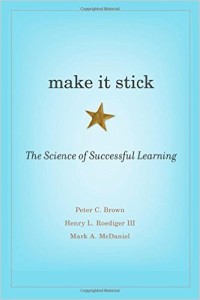 The discussion was led by Laura Bayard and Mandy Havert, and it was focused on the book Make it Stick: The Science of Successful Learning by Peter C. Brown et al. The co-authors are cognitive psychologists.
The discussion was led by Laura Bayard and Mandy Havert, and it was focused on the book Make it Stick: The Science of Successful Learning by Peter C. Brown et al. The co-authors are cognitive psychologists.
According to the authors, immutable aspects of learning are memory, lifelong learning and acquired skills. Learning is often misunderstood, for example people believe that information needs to be spoon fed to them and that reading and re-reading text will help them learn. Learning is deep and durable when it requires effort. Recalling and quizzing more effective ways of learning than re-reading notes. Low stakes quizzes are extremely effective at helping students learn and recall material over time. Retrieving and testing interrupts the process of forgetting.
It is best to have students do some pre-reading and pre-work before they come to class to learn. They need to have a foundation or framework to help them understand and this enables them to build on prior knowledge (scaffolding). It is best to draw on underlying principles/mental models when learning. Also it is helpful to interleave and vary your learning. Reflection on what has been learned is also helpful. Mix it up!
Some of the tips they had for teachers were to be transparent and explain to students how learning works and how to study. For example, if you are using quizzing to help students remember and learn, let them know that. Incorporate Bloom’s taxonomy, and explain to students the higher learning concepts up front.
Tips for library instructors:
- Have them do pre-work, like the Pot of Gold tutorial, or something similar.
- Quiz them on pre-work and/or information they learn in class. Mandy does this.
- Don’t make it too easy – let them struggle a little bit to use the sources you’re showing them.
- Instead of a one-shot, negotiate with the prof and have several shorter sessions over the course of the semester. Julie Tanaka is trying that with one of her classes this semester.
- Interleave what you are showing them. For instance, don’t show them all of the references sources, and then all of the journal sources, and then book sources. Mix it up so that they encounter each category several times, and not all at once.